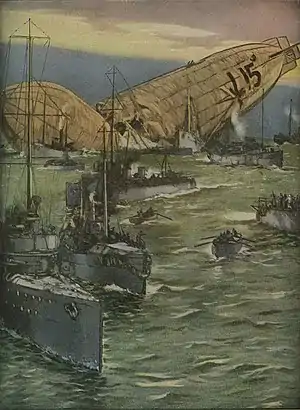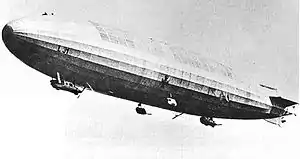LZ 61 (L 21)
The LZ 61 was a World War I German Navy airship, allocated the tactical numbering 'L 21'. It carried out a total of ten raids on England, and 17 reconnaissance missions.[1]
Silhouette of LZ 61 | |
| History | |
|---|---|
| Name: | LZ 61 |
| Operator: | Imperial German Navy |
| Builder: | Luftschiffbau Zeppelin |
| Maiden voyage: | 10 January 1916[1] |
| Identification: | L 21 |
| Fate: | Shot down, 28 November 1916 |
| General characteristics | |
| Type: | Airship |
| Length: | 163.5 m [1] |
| Beam: | 18.7 m ø [1] |
| Installed power: | Four 240 hp Maybach HSLu engines [1] |
| Speed: | 97 km/h [1] |
| Capacity: | 31,900 m³ Gas Volume [1] |
.png.webp)
Raids on England
The LZ 61 took part in a total of ten raids on England during 1916. These included:
- 31 January
- It was ordered to attack Liverpool, but problems with night navigation meant that instead it bombed Tipton, Bradley, Wednesbury, and Walsall: killing over 30 people - including Julia Slater, Walsall's Lady Mayoress.[2]
- 1 April
- It attacked Cleethorpes, dropping several bombs on the town just after midnight. One of which landed on the Alexandra Road Baptist Chapel, killing 31 soldiers of the 3rd Battalion the Manchester Regiment, who were billeted there.[3] One of the only British Army units to be directly engaged by enemy action on British soil during World War I.
- 2 September
- It took part in the largest airship attack of the war with 13 other naval airships and also four army airships - 16 in total. During this raid, the crew of the LZ 61 witnessed the downing of the SL 11, the first airship to be shot down over the British mainland.[4]
- 25–26 September
- It was unable to find its designated targets of Derby and Nottingham, and instead attacked Bolton,[5] Lumb, Rawtenstall, Ewood Bridge, Stonefold, Haslingden, Helmshore, Rossendale, Ramsbottom and Holcombe.[6]
Destruction of the LZ 61
On 27 November 1916, ten Zeppelins set out in two groups, heading for the Midlands and the North of England. One, the L.21, crossed the English coast at Atwick at 21:20, and then turned north to evade patrolling aircraft before heading to Leeds, where it was driven off by heavy anti-aircraft fire. An effective blackout shielded Barnsley from attack, so the airship headed southwest to the Potteries where it dropped a number of bombs on industrial targets in Stoke, causing some damage, but no casualties. At 01:30, it headed for home, setting a course towards Great Yarmouth. It was spotted by two RNAS aircraft north of Peterborough, but managed to evade them. Over East Dereham, it was spotted by Flight Lieutenant W. R. Gaynor, who was forced to abort his attack after suffering engine failure. However, reports of the L.21's movements had reached Great Yarmouth, so at dawn Egbert Cadbury and Flight Sub Lieutenant Gerard W. R. Fane took off in their B.E.2c fighters to intercept. They were joined by Flight Sub Lieutenant Edward L. Pulling from RNAS Bacton. Cadbury later reported:[7]
I saw the Zeppelin approaching the coast and immediately chased after it. It was flying about 5,000 feet when I first saw it and it immediately climbed to 8,000 feet. I went after it. I approached from the stern about 3,000 feet below and fired four drums of explosive ammunition in to its stern, which immediately started to light. At the same time one of the other pilots was flying over the Zeppelin and to his horror he saw a man in the machine-gun pit run to the other side and leap overboard. Having seen the Zeppelin circle down to the sea in a blazing mass – a most horrible sight – I went back to Yarmouth. I could not say I felt very elated or pleased at this; somehow I was overawed at the spectacle of this Zeppelin and all the people aboard going down into the sea.[7] [8]
Commanders
| From | To | |
|---|---|---|
| Kapitänleutnant Max Dietrich | 19 January 1916 | 4 July 1916 |
| Hauptmann August Stelling | 24 June 1916 | - |
| Oberleutnant Zee Kurt Frankenberg | 15 August 1916 | 28 November 1916 |
Operational bases
| From | |
|---|---|
| Nordholz | 19 January 1916 |
| Seddin | 21 February 1916 |
| Tønder | 5 April 1916 |
| Nordholz | 16 April 1916 |
Confusion with SL 11
For unknown reasons, when the SL 11 became the first German airship to be shot down over England, it was described officially and in the press as the Zeppelin L 21 (the LZ 61's tactical number). This misidentification persisted for decades, even though it is clear that the authorities were always aware of its correct identity.
One suggestion for this confusion was a calculation by the authorities that the downing of a hated and feared Zeppelin 'baby killer', would be received better with the public than the destruction of an almost unknown Schütte-Lanz type.[10]
Accordingly, the 1918 film The Last Raid of Zeppelin L-21 told the story of the SL 11's destruction and not that of the LZ 61.[11]
Zeppelins shot down over the UK
Airships made about 51 bombing raids on Britain during the war. These killed 557 and injured another 1,358 people. More than 5,000 bombs were dropped on towns across Britain, causing £1.5 million in damage. 84 airships took part, of which 30 were either shot down or lost in accidents.[12]
| Zeppelins shot down over the UK | ||||||||||||||||||||||||||||||||||||||||||||||||||||||||||||||||||||||||
|---|---|---|---|---|---|---|---|---|---|---|---|---|---|---|---|---|---|---|---|---|---|---|---|---|---|---|---|---|---|---|---|---|---|---|---|---|---|---|---|---|---|---|---|---|---|---|---|---|---|---|---|---|---|---|---|---|---|---|---|---|---|---|---|---|---|---|---|---|---|---|---|---|
|
References
- Puget Sound Airship Society (2007). "The Zeppelin Airships. Part Two: Zeppelins of the Great War 1914 - 1918". Puget Sound Airship Society.
- Morgan, Tom (1996). "31 January 1916 - The Great Zeppelin Raid". Brigham Young University: World War I Document Archive.
- Cook, Vernon (1999). "Zeppelin Disaster Casualty List - Cleethorpes Lincs 1916". WEST-RIDING-L Archives. Ancestry.com.
- James Burbeck (ed.). "Dark Autumn: The 1916 German Zeppelin Offensive". www.wtj.com: The War Times Journal. Archived from the original on July 19, 2010.
- Bolton Museum and Archive Service. "Zeppelin raid on Bolton". Bolton: Bolton Council.
- Bramhill, william; Bramhill, Elizabeth. "Zeppelin Attack on Rossendale". www.bramhill.net.
- Handford 2014.
- Holdstock, David; Holdstock, Amelia (2000). "Chapter 5 – Edward Laston Pulling: Fengates Hero". In Lewis, Andrew; Lewis, Sarah (eds.). A Celebration of Fengate Road. Redhill: FRIEND (Fengate Road Inclusive Entertainment & Neighbourly Development). Archived from the original on 2010-07-03. Retrieved 2010-07-03.
- "Zeppelin L 21". Tønder: Zeppelin and Garrison Museum.
- Rimell, Raymond Laurence (1984). Zeppelin!: a battle for air supremacy in World War I. London: Conway Maritime Press. ISBN 978-0-85177-239-4. OCLC 10759648.
- Erickson, Hal. "The Last Raid of Zeppelin L-21". Allmovie.com.
- Liddell Hart, Sir Basil Henry (1934). A History of the World War 1914–1918. Faber. p. 76. ISBN 9780304936533.
- Handford, Paul (3 July 2014). "The story of Egbert 'Bertie' Cadbury and his remarkable achievement during WWI" (PDF). Birmingham Medal Society. Retrieved 23 November 2016.




